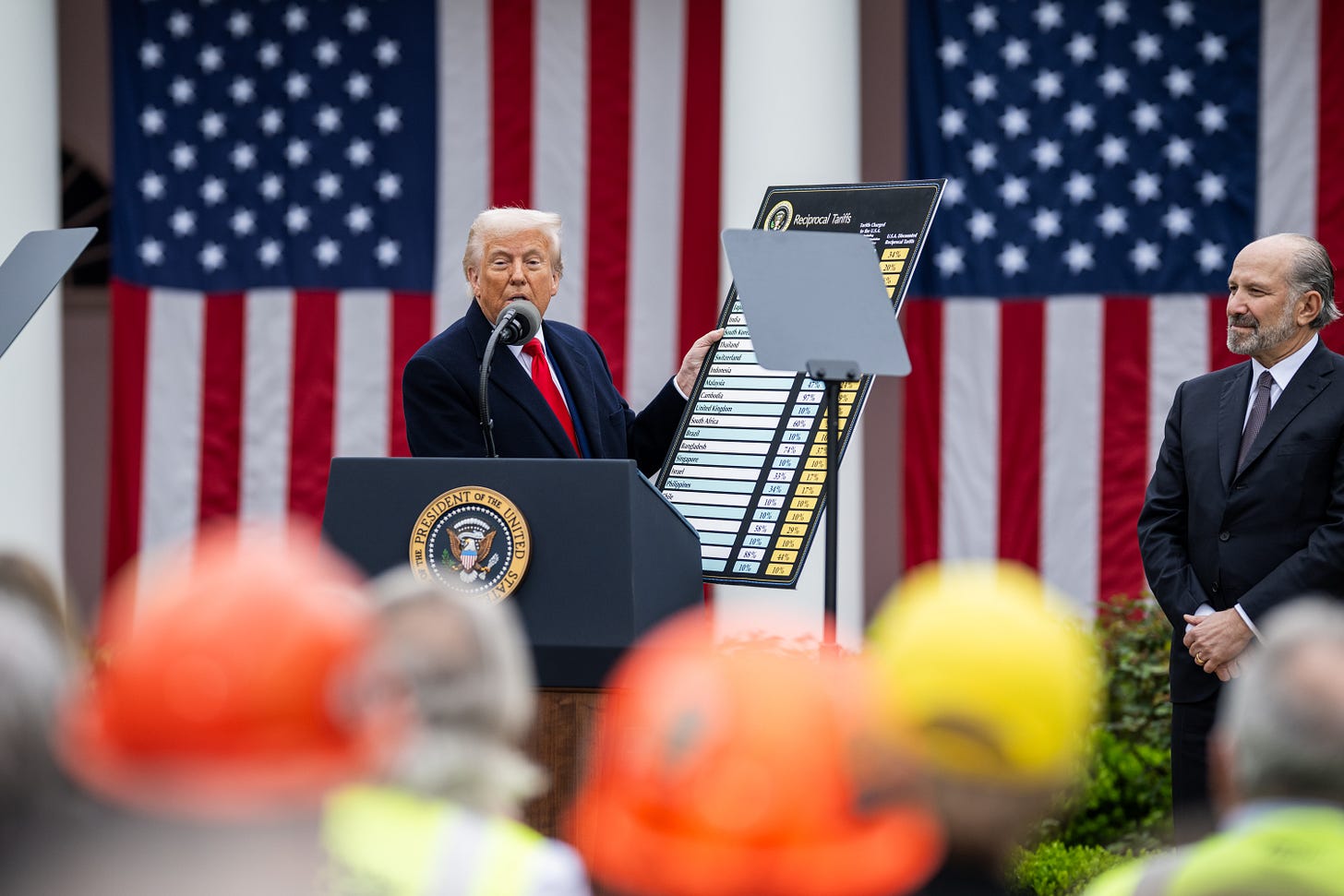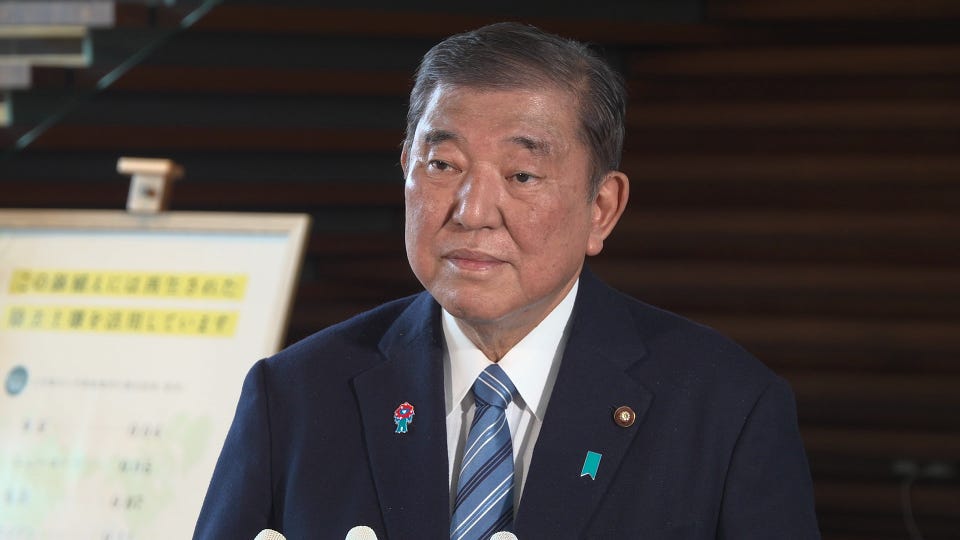Thank you for reading Observing Japan. This post is available to all readers.
If you are looking for timely, forward-looking analysis of the stories in Japans’s politics and policymaking that move markets, I have launched a new service through my business, Japan Foresight LLC. For more information about Japan Foresight’s services or for information on how to sign up for a trial or schedule a briefing, please visit our website or reach out to me.
I will be holding another monthly conference call for paid subscribers the week of 14 April. Stay tuned for more details and upgrade to a paid subscription below to join.
Check out a new article I wrote for Foreign Policy — “Japan Can’t Trust That Things Are Normal With Washington” — here.

Onodera Itsunori, the Liberal Democratic Party’s (LDP) policy chief, appeared on BS Fuji’s evening news on Thursday, 3 April and offered a blunt assessment of the situation Japan faces after US President Donald Trump announced on Wednesday, 2 April that Japan will face 24% “reciprocal” tariffs on all of its exports to the United States starting on 9 April.
The situation, Onodera said, “is approaching a national crisis.”

The Ishiba government had already been bracing for 25% automobile tariffs, which would be a significant blow to Japan’s leading export industry, which provides nearly 30% of Japan’s exports to the United States. It was not prepared for all of Japan’s exports to be hit with the same level of tariffs. A new forecast from the Daiwa Institute of Research released following Trump’s announcement suggests that Japan’s real GDP could fall by 0.7% in the near term and 1.8% over the medium term. Whatever the ultimate number, the effects are likely to be widespread, affecting large businesses and small businesses and all parts of the country, before even considering the possibility of a global slowdown, financial market disruptions, and abrupt exchange rate movements. Or, for that matter, the prospect that, in the words of the Nikkei Shimbun, “With these measures, the U.S.-led free trade regime has collapsed and the world order has reached a turning point,” a development that could force Japan’s leaders to consider the emerging gap between its alliance with the United States and its commitment to a rules-based international order.1
Prime Minister Ishiba Shigeru and his government have moved quickly to develop a response to the Trump Shock. The prime minister, after consulting with cabinet ministers and Onodera and other LDP officials, articulated an approach that will focus first on collecting information to asses the real impact of the tariffs on Japan’s economy; using public financial institutions to extend credit to businesses, particularly small businesses affected by the new trade barriers; and urging large businesses to pay their suppliers more to preserve their supply chains and protect small businesses. He also instructed Onodera to gather information about the impact on the economy, particularly on small businesses, and potentially prepare policy measures in response. His government will not, however, retaliate against the United States, not only because it fears the potential impact on the bilateral security relationship, but also because it may lack the statutory authority and also fears that retaliatory tariffs on US exports to Japan could be inflationary at a time when the Ishiba government is already struggling to contain cost-of-living increases. The Ishiba government will continue to pursue negotiations with the Trump administration, even though it may be reaching the conclusion that Trump himself is the only player who matters on trade — meaning that ministerial or working-level talks have limited utility — and the White House itself may not be interested in negotiations.
But, as Onodera suggested, this is not just an economic crisis. It is a national crisis, with implications not just for Japan’s businesses, workers, and households, but for its political system and its relations with the world. It is therefore important to consider how the “Trump Shock” will disrupt Japan’s politics in the near term.

Ishiba, of course, enters the crisis in a highly vulnerable position, with his approval ratings having fallen sharply and some LDP members ready to replace him with upper house elections approaching. Discontent in the party already led the LDP to establish a taskforce to respond to tariffs even before Wednesday’s announcement. The LDP’s right wing appears ready to use the crisis to pressure Ishiba and perhaps force him to resign. Takaichi Sanae, meeting with conservative LDP lawmakers on Thursday, slammed Ishiba for not naming a special envoy who could negotiate face-to-face with the United States, making it unclear whether anyone is in control of the situation in the Japanese government.2
But Takaichi and the LDP’s right wing may not necessarily have the last word on Ishiba’s fate. To the extent that both elites and the public agree that Japan does face an extraordinary situation — and, having watched how major television stations covered the tariffs on their Thursday evening news programs, there is good reason to think this consensus will form3 — it may strengthen Ishiba’s position. Of course, even before Wednesday, it would have been difficult — and risky — for the LDP to try to replace Ishiba in the middle of a Diet session, with upper house elections approaching. Now, in the midst of an acute shock, it may be virtually impossible. Ishiba may also be helped by a “rally-around-the-flag” effect. After all, the unexpectedly expansive “reciprocal” tariffs, applying to more countries and at a higher level than virtually anyone expected, suggests that there is virtually nothing that Ishiba could have done before the tariffs were announced that would have spared Japan. It is not something that could have been prevented by posing a “tough negotiator” or Abe-style “flattery diplomacy.” Instead, it is a crisis that will have to be managed through effective leadership.
The question then is whether Ishiba is able to leverage the Trump Shock in the near term to stabilize his government and enable him to govern more effectively. To do this, he will have to do two things.
First, given that he leads a minority government, dependent on the cooperation of opposition parties, he needs to find a way to make peace with the opposition, despite the ongoing bruising fights over political reform and the pending battle over legislation to allow spouses to use separate surnames. He will, in short, need some kind of political truce with the opposition parties, especially if it turns out that the tariff crisis requires a stimulus package (i.e. a supplemental budget) to deliver relief to businesses and households. Of course, a national unity government that brought one or more opposition parties into a new coalition would be even better for Ishiba, but it seems unlikely that opposition parties will sign on for this ahead of the upper house elections.
To this end, Ishiba will convene an extraordinary meeting with the heads of six parties, including Kōmeitō, the Constitutional Democratic Party (CDP), the Democratic Party for the People (DPFP), Ishin no Kai, the Japanese Communist Party (JCP), and Reiwa Shinsengumi. That this meeting, being billed as an opportunity for Ishiba to brief the opposition leaders on the situation and to hear their views, is happening at all gives some indication that Japan faces an extraordinary situation. It remains to be seen what results from this meeting, but it points to Ishiba’s recognition that he needs to secure some sort of temporary truce in order to manage the crisis.
Second, Ishiba needs to ensure that the LDP is united behind him. In some ways this may be harder, not least given that while the opposition parties did not see Ishiba’s removal as an urgent problem even before the Trump Shock,4 Ishiba’s bitterest rivals in the LDP see him as an obstacle to the party’s performing well in July and had begun calling for his resignation. As Takaichi’s criticism suggests, they may not feel particularly charitable towards Ishiba or inclined to rally around Ishiba, convinced that they could do a better job managing Trump. To neutralize their resistance, Ishiba may need to do something to placate them. This is purely speculative, but I wonder whether Ishiba will need to do a limited cabinet reshuffle. His cabinet and LDP leadership team were, of course, drawn exclusively from his supporters, in part because Takaichi and her supporters refused to accept the largely ceremonial roles Ishiba offered them. He might need to bring them into the tent in a more formal capacity, and perhaps take up Takaichi’s call for a state minister whose portfolio would be managing the government’s response to the Trump tariffs and include direct negotiations with the US administration. The latter could be a job for Motegi Toshimitsu, who has presented himself as a Trump whisperer and was also excluded from power last year.
The bottom line is that to weather a crisis that could shake the very foundations of Japan’s foreign policies stretching back eighty years, Ishiba needs all political parties to recognize that this is not politics as usual, and, while Japan is a democracy that can and should hold Ishiba accountable and hold elections as usual in July, the government needs to be able to act quickly and decisively. If Ishiba cannot impress upon his opponents the gravity of the situation, Japan could find itself in the worst possible situation, with weak, unstable leadership just as it needs a government capable of responding to a fast-changing situation that could pose a major ongoing threat to Japan’s most fundamental interests.
Trump’s reminiscing about his relationship with Abe Shinzō probably does Ishiba no favors in helping his right-wing rivals draw unfavorable contrast between Ishiba and the late Abe. Indeed, Yamamoto Ichita, conservative LDP lawmaker-turned-Gunma governor, did precisely that.
Every network I watched noted — and seemed to be amused by — the inclusion of uninhabited Antarctic islands on the list of tariff targets.
Indeed, they thought that Ishiba staying in power would be good for their chances in July.





